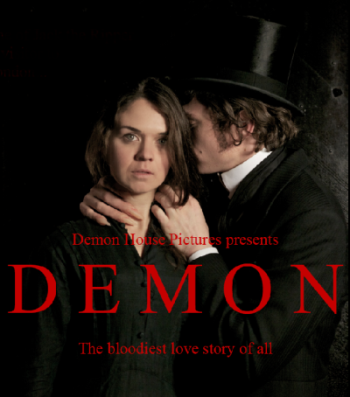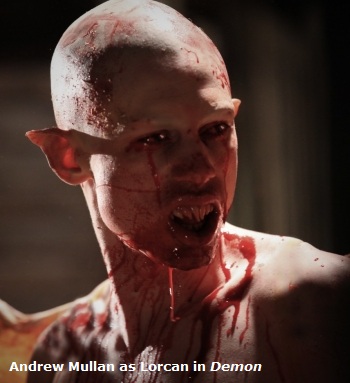NOT ALL ROMANTIC BLOOD-SUCKERS ARE VAMPIRES: DEMON
by Thomas M. Sipos, managing editor [September 1, 2012]
 [HollywoodInvestigator.com] Period pieces always present additional challenges for low-budget horror films. How to re-create Victorian England on a dime? [HollywoodInvestigator.com] Period pieces always present additional challenges for low-budget horror films. How to re-create Victorian England on a dime?
Writer/director Mark Duffield tackles that challenge with Demon, a film whose ambiance evokes a poor man's The Doctor and the Devils and Bram Stoker's Dracula.
Demon also resembles Bram Stoker's Dracula in that it includes a romance between a young innocent woman (Clare Langford) and a dashing beau (Andrew Mullan) -- who transforms into a monster.
"My impulse was to create a horror love story set in the late 1800s," says Duffield, who claims to be influenced by the Hammer and Amicus Victorian horror films of the 1960s and '70s. "I've always been fascinated by the Victorian period. It was a rich time for scientific and literary invention -- and for dark tales.
"I also admire David Lynch's The Elephant Man in the way it captures and conveys the spirit and atmosphere of that time using black and white. However, I was keen to make Demon in color. Look at the pre-Raphaelite paintings, or the artworks of Walter Sickert or John Atkinson Grimshaw. See how vibrant that period was. I wanted to bring that color to the screen. In terms of style David Lean was an inspiration. I wanted to capture a "classic" feel: well-composed shots, gentle tracking, no handheld camera, spare editing."
 Lorcan (Duffield's demon) has qualities traditionally associated with vampires. Lorcan is a romantic who needs blood to survive. (Like a werewolf, he destroys the one he loves.) But unlike vampires, romantic demons are scarce on screen. (Does the lovesick succubus in Incubus count?) Lorcan (Duffield's demon) has qualities traditionally associated with vampires. Lorcan is a romantic who needs blood to survive. (Like a werewolf, he destroys the one he loves.) But unlike vampires, romantic demons are scarce on screen. (Does the lovesick succubus in Incubus count?)
"I was intent on creating something fresh, given how much vampire stuff is out there," says Duffield. "The myth of the incubus and the curse of their progeny captivated and disturbed me. I found that the vampire myth sprang from the demon myth. Demons show up across many cultures. The djinn of Arab lore depicts demons as the original inhabitants of Earth, cast out by God in preference for humans. Then there's Lilith, the mythological first female demon, whose demise is described in Hebrew text. Every religion seems to have a demon in some form.
"Kafka's Metamorphosis and its metaphor of transformation inspired me to comment on how we sometimes transform when in love. The idea of the curse being "activated" by love gave me the romantic concept. Finally, I was inspired by the image I had of a demon in a Victorian top hat, and thought it would make an original monster."
Demons are usually fully evil; fallen angels who've chosen their fate by rejecting God, often out of jealousy of God's love for man. But Demon's Lorcan is not a supernatural angel, but biologically descended of angels. Like many romantic vampires, and like the reluctant anti-Christ in Lost Souls , Lorcan is a cursed innocent, fated to do evil.
"There is a theological reference to the Christian belief that demons are angels who have fallen from grace and side with Satan, and are put on earth to torment mankind," says Duffield. "When Lorcan visits the church, his demonic heritage makes him feel uneasy. He makes a quick exit. But I was more interested in using the demon as a metaphor for romantic love and what it does to us. How we twist and distort ourselves, and perhaps feel monstrous as we reveal ourselves and our demons to a loved one."

Demon effectively recreates Victorian London. The city is full of old buildings. Duffield frames many street scenes in low angles, so we only see the upper parts of buildings and of London Bridge. By keeping the streets out of frame, we don't see all the cars and people in modern dress. (Low-budget filmmakers can't always pay a city to shut down a major bridge.) Many outdoor scenes are shot on rooftops.
"One reason for filming the rooftops was to avoid contemporary London," Duffield admits. "But also I felt it created an interesting visual style. The rooftops are still true to how they were over a hundred years ago. It added to the authenticity.
"The biggest challenge was managing the entire production on my own. We had a small regular crew of set designer, costume, and makeup. Many times, I was organizing the production schedule, catering, props, costumes, as well as being cinematographer and director. We filmed for over a year, so I was able to pace myself. I kept the production low-key to avoid negative comments."
The film was shot on a Canon 5D, at 24P 1080P with a set of L series lenses, primes and zooms. It was edited on Apples Final Cut Pro X. "It's great editing software that’s been underestimated, but for independent filmmakers it truly encourages creative choices and freedom to edit quickly."

Demon was "independently funded." Duffield has begun entering it into film festivals, in hopes of securing distribution. In the meanwhile, he has his day job. "I work in film production at one of the key drama schools in London. I was able to use the studios to build sets, have a costume and makeup store, and get the support form the abundance of young talented actors I know."
Duffield has worked as a cinematographer on eight features films. He won for Best Cinematography at the 2006 Slam Dunk Festival for Butterfly Man. His directorial debut was Ghost of the Mae Nak.
|
